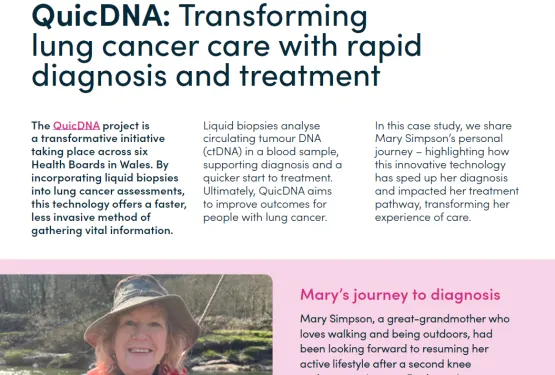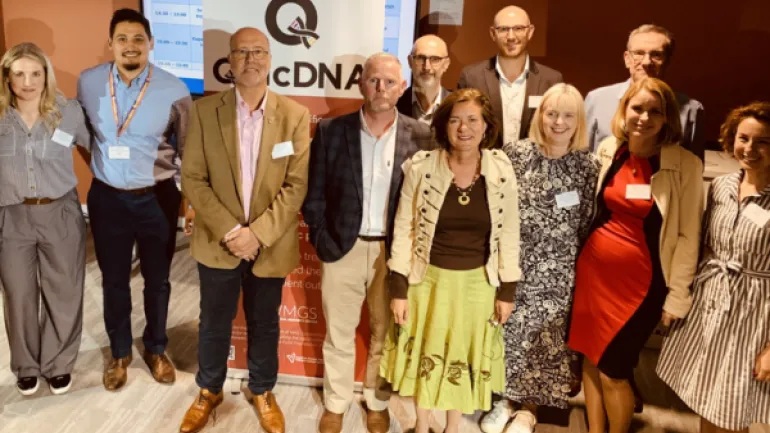The QuicDNA project is a transformative initiative taking place across six Health Boards in Wales. By incorporating liquid biopsies into lung cancer assessments, this technology offers a faster, less invasive method of gathering vital information.
Liquid biopsies analyse circulating tumour DNA (ctDNA) in a blood sample, supporting diagnosis and a quicker start to treatment. Ultimately, QuicDNA aims to improve outcomes for people with lung cancer.
In this case study, we share Mary Simpson’s personal journey – highlighting how this innovative technology has sped up her diagnosis and impacted her treatment pathway, transforming her experience of care.
Mary’s journey to diagnosis
Mary Simpson, a great-grandmother who loves walking and being outdoors, had been looking forward to resuming her active lifestyle after a second knee replacement in 2023. But by spring 2024, she began experiencing persistent leg pain, which was put down to a trapped nerve.
“I thought, brilliant, I can get back to doing some reasonable walking again. But that was when a pain in my leg began, and that was the beginning of all these problems,” Mary recalls.
A routine blood test revealed very high B12 levels, and she was sent for a CT scan. While on holiday in Cornwall, Mary received a phone call that set her on an unexpected path.
“A phone call at 9am on the Monday morning and I thought, golly, something is wrong for the doctor’s surgery to be calling at that time,” she says.
An appointment was made for her GP to call later, when she was told that the scan had revealed a small spot on her left lung. The day after returning home from Cornwall, Mary had an appointment for an MRI scan.
Just days before her 80th birthday, Mary was diagnosed with lung cancer and secondary bone cancer.
Although Mary praises her healthcare team, the news was a shock for her and her family.
“Our daughter was with us when we were first told, and I think our whole family went into shock,” she says.
How QuicDNA transformed Mary’s care
Mary’s next steps included respiratory consultations and additional testing. As part of her assessments, Mary had a liquid biopsy blood test, through the QuicDNA lung cancer project.
This innovative test significantly shortened the time to treatment, providing critical information for her clinical team weeks ahead of traditional methods. Mary was able to begin targeted lung cancer treatment in September 2024, an entire month before tissue biopsy results, which would not have been available until October.
Dr Paul Shaw, Consultant in Clinical Oncology at the Velindre Cancer Service, highlights the profound clinical and emotional impact:
“Mary’s case demonstrates the transformative potential of rapid ctDNA analysis. The psychological impact of waiting for diagnostic results cannot be overestimated; this can be a source of very understandable concern for many patients and families who without ctDNA results may wait patiently for weeks at such a difficult time.”
This accelerated pathway allowed Mary to receive care from the oncology team much sooner, reinforcing the value of liquid biopsy as a game-changer in lung cancer diagnostics and treatment.
Positive outcomes and next steps
Mary felt an improvement almost immediately after starting treatment. The leg pain that disrupted her daily life, vanished. While she experienced some side effects, adjustments to her medication alleviated them.
In January 2025, Mary received encouraging scan results:
“The tumour on my lung has shrunk a bit, and my understanding is that where the cancer has gone into my bone, it’s contained and hasn’t got any worse. I think I’m still in shock, it really knocks you sideways.”
Mary continues to have scans every three months and remains optimistic. She says:
“You’ve got to stay positive. I’m quite a philosophical person and I take every day as it comes, which is all you can do.”
About QuicDNA and liquid biopsies
The QuicDNA project is paving the way for faster, more effective cancer care through innovative testing methods. Liquid biopsies offer a minimally invasive, rapid alternative to traditional diagnostics, enabling earlier intervention and better outcomes.
Learn more about the project here.




